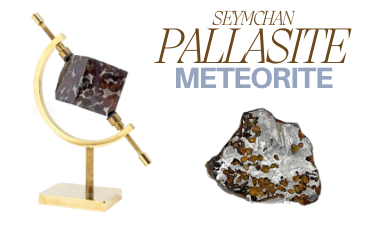Seymchan Meteorite | Information, History, Properties All Entries

The Seymchan meteorite is a remarkable extraterrestrial specimen that has captivated scientists and collectors alike since its discovery in the remote region of Magadan, Russia, in 1967. Named after the nearby Seymchan River, this meteorite showcases a captivating blend of metallic and stony components, making it a unique and sought-after piece in the world of meteoritics.
Seymchan is classified as an iron-pallasite meteorite, an intriguing type that exhibits a combination of iron-nickel metal and silicate minerals. Within the Seymchan meteorite, these two components are intricately entwined, creating a striking visual contrast. The metallic matrix, composed primarily of iron and nickel, forms a network of intricate patterns known as the Widmanstätten pattern, which is characteristic of iron meteorites. Embedded within this metallic matrix are scattered pockets of yellow-green olivine crystals, adding a vibrant touch to the overall composition.
The story of Seymchan's journey to Earth began billions of years ago during the formation of our solar system. It is believed to have originated from a disrupted parent body, possibly an asteroid or a planetesimal, where the core and mantle materials mixed due to a cataclysmic impact. The resulting fragments were scattered throughout space, eventually finding their way to our planet as meteorites.
The Seymchan meteorite has gained recognition not only for its intriguing composition but also for its exceptional preservation. While many meteorites endure significant alteration upon atmospheric entry and impact with the Earth's surface, Seymchan specimens often exhibit a remarkable fusion crust—a thin, dark layer formed during atmospheric entry—which preserves the meteorite's pristine appearance. This makes Seymchan meteorites highly desirable for scientific research and collections.
Scientists have extensively studied Seymchan meteorites to unravel the mysteries of the early solar system. Through careful analysis of the minerals present, researchers can determine the chemical composition and isotopic ratios, shedding light on the processes that occurred within the parent body. By studying Seymchan and other meteorites, scientists gain insights into the formation and evolution of asteroids and the larger bodies in our solar system.
The Seymchan meteorite has also captivated the interest of collectors worldwide. The combination of its striking aesthetics, rarity, and intriguing backstory makes it a highly sought-after piece among meteorite enthusiasts. Seymchan specimens can be found in private collections, museums, and institutions, where they serve as tangible reminders of the vastness and beauty of the cosmos.
In conclusion, the Seymchan meteorite stands as a testament to the wonders of our universe. With its captivating blend of metallic and stony components, it offers a glimpse into the processes that shaped our solar system billions of years ago. Whether admired for its scientific significance or its aesthetic appeal, Seymchan continues to inspire awe and curiosity, reminding us of the extraordinary stories that lie within the rocks that fall from the sky.



